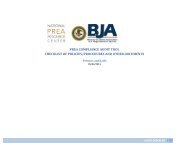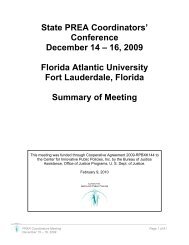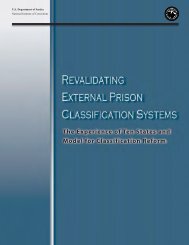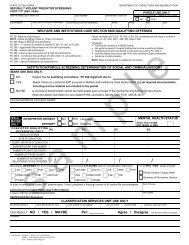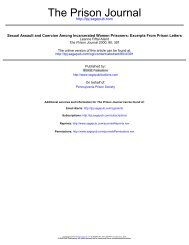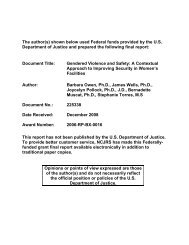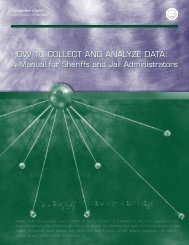Virginia Report of PREA Pre and Post Test Scores - The National ...
Virginia Report of PREA Pre and Post Test Scores - The National ...
Virginia Report of PREA Pre and Post Test Scores - The National ...
- No tags were found...
Create successful ePaper yourself
Turn your PDF publications into a flip-book with our unique Google optimized e-Paper software.
<strong>The</strong> Impact <strong>of</strong> <strong>PREA</strong> Staff Training<strong>The</strong> <strong>PREA</strong> grant awarded to the <strong>Virginia</strong> Department <strong>of</strong> Corrections (VADOC) containedthree goals that required design <strong>and</strong> delivery <strong>of</strong> staff <strong>and</strong> inmate training on inmate sexual assault<strong>and</strong> increased knowledge on best practices in h<strong>and</strong>ling <strong>and</strong> preventing prison assaults. <strong>The</strong> firstgoal was to increase staff expertise on sexual assault awareness, effective h<strong>and</strong>ling, <strong>and</strong>prevention. Tasks to accomplish this goal included researching sexual assault training programsfor correctional staff, developing a staff training program on inmate sexual assault, incorporating<strong>PREA</strong> training in basic training for all new VADOC employees, <strong>and</strong> conducting processevaluations <strong>of</strong> the impact <strong>of</strong> this training. Another goal was to train veteran VADOC staff toincorporate best practices in h<strong>and</strong>ling <strong>and</strong> preventing prison sexual assault on inmates. Whenthis goal was incorporated into the grant, it was envisioned that veteran staff would be h<strong>and</strong>ledvia a web-based distance learning training program. However, VADOC <strong>of</strong>ficials decided toinclude <strong>PREA</strong> training in yearly m<strong>and</strong>atory training for all veteran staff so there was no need todeploy this training via distance learning. A third goal was to decrease the level <strong>of</strong> inmatevictimization. Tasks to accomplish this goal included researching sexual assault trainingprograms for inmates, developing an inmate training program on prevention <strong>of</strong> sexual assault,<strong>and</strong> delivering the training to inmates during their reception phase. <strong>The</strong> inmate <strong>PREA</strong> trainingwas also <strong>of</strong>fered to all inmates at each institution during 2007 <strong>and</strong> 2008.A primary performance measure <strong>of</strong> the effectiveness <strong>of</strong> <strong>PREA</strong> staff training was analysis <strong>of</strong>knowledge <strong>and</strong> attitude gains as a result <strong>of</strong> <strong>Virginia</strong> Department <strong>of</strong> Correction’s comprehensiveinmate sexual assault prevention program. This report details the performance measures <strong>of</strong> the<strong>PREA</strong> training for VADOC staff. <strong>The</strong> performance measures for this goal included gatheringthe total number <strong>of</strong> staff who received the <strong>PREA</strong> staff training. An additional performance
measure required gathering <strong>and</strong> analyzing pre-test <strong>and</strong> post-test results (gains in staff knowledge<strong>of</strong> sexual assault awareness, knowledge <strong>of</strong> prevention <strong>of</strong> inmate sexual assault, expertise ineliciting sexual assault reports, <strong>and</strong> effective h<strong>and</strong>ling <strong>of</strong> inmate sexual assault) <strong>of</strong> the staff’scompetency scores. Roughly 9,000 staff completed the <strong>PREA</strong> training in CY 2007. Of thisnumber, a r<strong>and</strong>om sample <strong>of</strong> pre-test <strong>and</strong> post-test results <strong>of</strong> 745 VADOC staff who completed<strong>PREA</strong> training was analyzed.Research Population: <strong>The</strong> research population was a r<strong>and</strong>om sample <strong>of</strong> the pre-tests <strong>and</strong> posttests<strong>of</strong> seven hundred <strong>and</strong> forty five (745) <strong>Virginia</strong> Department <strong>of</strong> Corrections staff whoparticipated in <strong>PREA</strong> training between August <strong>and</strong> October <strong>of</strong> 2007. <strong>The</strong> sample populationincluded VADOC staff who have either direct or indirect contact with <strong>of</strong>fenders. <strong>The</strong> samplepopulation included support staff such as Correctional counselors, <strong>of</strong>fice personnel, medicalstaff, teachers, <strong>and</strong> postal assistants. Correctional staff included executive staff (Majors <strong>and</strong>Lieutenants) <strong>and</strong> Correctional Officers. <strong>The</strong> majority <strong>of</strong> the trainees (51%) were CorrectionalOfficers. Of the 745 trainees sampled, 380 were Correctional Officers. <strong>The</strong> other staffcategories sampled included 63 Counselors or Medical personnel (8.5%); 237 support staff(31.8%); 17 teachers or trainers (2.3%), 19 upper management (2.6%) <strong>and</strong> 29 unknown positions(3.9%). A visual representation <strong>of</strong> the staff category percentages in the research samplepopulation is given in Chart 1.
Chart 1: Staff Category Percentages in the <strong>PREA</strong> Trainee Research SampleMethodology: Prior to the start <strong>of</strong> each <strong>PREA</strong> training session, pre-tests were given to traineesto gauge their knowledge level <strong>of</strong> inmate sexual assault <strong>and</strong> best practices in h<strong>and</strong>ling <strong>and</strong>preventing sexual assault in prisons. After completing the <strong>PREA</strong> training course, traineescompleted another post-test that re-assessed their knowledge about inmate sexual assault. <strong>The</strong>paired pre-tests <strong>and</strong> post-tests were then analyzed by <strong>PREA</strong> research analysts. Gains (or losses)in competency scores on <strong>PREA</strong> knowledge were assessed by subtracting the pre-test score fromthe post-test score <strong>of</strong> each trainee. <strong>The</strong> following report describes the trainee population, meanscores on pre-tests <strong>and</strong> post-tests, <strong>and</strong> net gains in competency scores after <strong>PREA</strong> training.Results: Descriptive statistics (mean averages) were used to examine the mean average scores<strong>of</strong> the sample population on their pre-tests <strong>and</strong> their post-tests. <strong>The</strong> pre-test mean average was69.93. With a passing score <strong>of</strong> 70, this indicated that the average score before <strong>PREA</strong> trainees
went through the training course was not a passing score. <strong>The</strong> post-test mean average scoreincreased to 87.98. This is an average score increase <strong>of</strong> 18 points after <strong>PREA</strong> training.Chart 2: Comparison <strong>of</strong> Mean <strong>Scores</strong> on <strong>PREA</strong> <strong>Pre</strong>-test <strong>and</strong> <strong>Post</strong>-test <strong>Scores</strong>Further analysis <strong>of</strong> pre-test scores indicated that over half <strong>of</strong> the staff 53.8% (401) had scores <strong>of</strong>70% or below while only 8.1% (61) scored 90% or greater. <strong>The</strong> post-test scores showed theopposite skew – a majority <strong>of</strong> trainees (57% or 425 <strong>of</strong> the 745) scored higher than 90% whileonly 11.3% (84) staff scored 70% or lower. <strong>The</strong>se data show a reversal in overall scoring totalsbetween pre-test <strong>and</strong> post-test scores after completion <strong>of</strong> <strong>PREA</strong> training.
Chart 3: Staff Scoring 70% or Below on <strong>PREA</strong> <strong>Pre</strong>-tests <strong>and</strong> <strong>Post</strong>-testsChart 4: Staff Scoring 90% or Above on <strong>PREA</strong> <strong>Pre</strong>-tests <strong>and</strong> <strong>Post</strong>-tests
Summary <strong>and</strong> Conclusion: Performance measures <strong>of</strong> the impact <strong>of</strong> <strong>PREA</strong> staff training usedpre-tests given prior to training <strong>and</strong> post-tests after completing training to gauge changes in staffknowledge level <strong>of</strong> inmate sexual assault <strong>and</strong> best practices in h<strong>and</strong>ling <strong>and</strong> preventing sexualassault in prisons. <strong>The</strong> paired pre-tests <strong>and</strong> post-tests <strong>of</strong> a sample <strong>of</strong> 745 <strong>Virginia</strong> Department <strong>of</strong>Corrections staff were analyzed using descriptive statistics. <strong>The</strong> sample population includedVADOC staff who have either direct or indirect contact with <strong>of</strong>fenders. <strong>The</strong>y includedCorrectional Officers (51%), counselors or medical personnel (8.5%), support staff (31.8%);teachers or trainers (2.3%), management staff (2.6%) <strong>and</strong> 29 unknown positions. <strong>The</strong> staff wastrained between August <strong>and</strong> October 2007.Analysis using descriptive statistics indicated that the pre-test mean average was 69.93.With a passing score <strong>of</strong> 70, this indicated that the average pre-test score was not passing. <strong>The</strong>post-test mean average score increased to 87.98. This is an average score increase <strong>of</strong> 18 pointsafter <strong>PREA</strong> training. Further analysis <strong>of</strong> pre-test scores indicated that over half <strong>of</strong> the staff53.8% (401) had scores <strong>of</strong> 70% or below while only 8.1% (61) scored 90% or greater. <strong>The</strong>post-test scores showed the opposite skew – a majority <strong>of</strong> trainees (57% or 425 <strong>of</strong> the 745)scored higher than 90% while only 11.3% (84) staff scored 70% or lower. <strong>The</strong>se data show areversal in overall scoring totals between pre-test <strong>and</strong> post-test scores after completion <strong>of</strong> <strong>PREA</strong>training.



